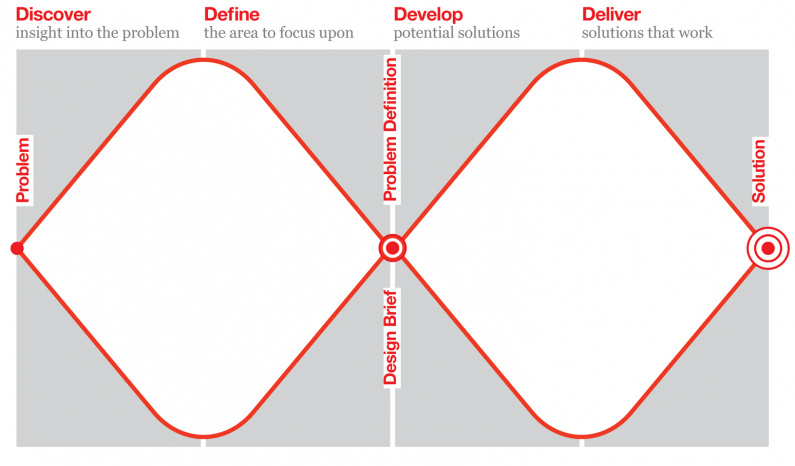Double Diamond is the name of a design process model developed by the British Design Council in 2005. Divided into four phases — Discover, Define, Develop and Deliver — it is probably the best known and the most popular design process visualization.
The main feature of the Double Diamond is its emphasis on the “divergent” and “convergent thinking”, where first many ideas are created, before refining and narrowing down to the best idea. This is happening twice in this model — once to confirm the problem definition and once to create the solution.
While this is all fine, I have always had some problems with the Double Diamond. Namely:
- It’s completely separating the analysis/discovery and the definition of the problem from the ideation and the delivery of the solution(s). It’s very linear and this is not how great designers really work. Designers are starting with some solution in mind, and there is nothing wrong with that, if they are not too attached to their first ideas. Most design problems are “wicked problems” — such problems are not understood properly until after the formulation of a solution. The vision of the solution stimulates the research and framing of the problem, which is informing and shaping the vision of the solution, and so on.
- In the middle of the process there is something called “Design Brief” or “Problem Definition”, but to me any written “documents of vision” or specifications are not really good starts for a design. They are boring, lifeless, uninspiring and often dead on arrival. (Prototypes are much better as both vision of the solution and definition of the problem.)
- It seems this process gives much more prominence to the Design Brief than to the Design Concept, which to me is a crucial element of the whole design process.
- It’s reinforcing the image of the “big research up-front” as the best practice for all design work, which often doesn’t make any sense.
So for a while I was thinking how to create a better visualization of my design process in the most simple way, and finally I came up with the model below.
I don’t really know how to call it — maybe “The Three Triangles Process”? 😀 (And please forgive me the colors, I think I was inspired by the new Slack logo. 😉)
It consists of the three triangles representing the three main activities of every design process: Discovery (analysis of the problem space), Ideation (thinking up the solutions), and Delivery (or implementation).
There are also three main artifacts or milestones: The Brief, which is the initial design problem or vision of the outcome, The Concept, which is the initial prototype of the selected solution, but also a tangible (re)definition of the problem, and The Product, which is the final design ready for the market.
- We start with The Brief, but this is only the beginning, and we all know briefs are usually not very good. Designers really need to step aside to explore the problem and different possible solutions through analysis and ideation.
- Discovery and Ideation are running in parallel from the start as they should. They are not separate stages, one informs the other. Discovery may consists of workshops with the client and gathering of the requirements, analysis of the current state, user research, research of the competition, analysis of the technology, simply seeking inspiration, etc. Ideation is the process of thinking up and prototyping different solutions — it involves thinking about features, interactions, information architecture, processes, content, UI, and the most fundamental — target group and business model. We start exploring many different directions (“divergent thinking”) to finally select the one most promising idea (“convergent thinking”). That’s what these triangles are symbolizing. 😀 (Double Diamond makes it look like first we only use divergent thinking for a few weeks, and then only convergent thinking. This is of course not true at all. These two modes of thinking must be used together — at the beginning divergent thinking is prevailing, but ultimately we need one answer, so convergent thinking is needed to eliminate, structure and organize.)
- The one most promising solution is The Concept, which is the idea given form of a simple prototype or a mockup of the main screens of the application. This is the final outcome of the Discovery and Ideation stages. At this time all stakeholders should agree: this is it, this is what we should be doing!
- The Concept is the design direction, but in most cases it is still very open, vague and quite far from the final product. Much more work is needed to flesh it out, make it more detailed, specific and feasible. We still need to move from “this can work like this, or like this, or like that…” to one final answer for every question. This is the goal of the Delivery phase, where all scenarios, processes, screens and states need to be thought-out.
- And at the end of Delivery phase we should have The Product ready for the market.
So… I’m not sure this model is ideal, but there are some things I rather like about it:
- The Discovery and Ideation stages running simultaneously, not one after each other.
- The central role of the Design Concept.
- The Delivery (or Implementation) stage is the largest of the three triangles, as in real life it’s usually the longest and the most difficult part.
- Product testing with users can take place through the whole process, not just at the end of it — from Discovery & Ideation (testing multiple concepts created during the Ideation) to Delivery (usability testing).
- And it’s all very simple!
And what do you think?
This article was originally published at UX Collective on Medium. It's also available in Korean: 더블 다이아몬드를 넘어 : 더 나은 디자인 프로세스 모델에 대한 생각


No comments.